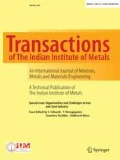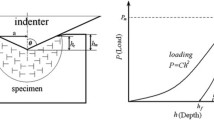Abstract
In this study, firstly we introduced general mathematical concepts related to the geometrical form of ellipse and ellipsoid. Secondly, the hardness was calculated when we used an indenter having a geometrical shape of an oblate spheroid; the mathematical expressions of static hardness were determined as functions of the applied load, the radius or the depth of the imprint area. The general static hardness formula was expressed considering the projected and the real area imprint of the oblate spheroid indenter. Thirdly mathematical assumptions were introduced in order to simplify the mirohardness and nanohardness formulas when we used the real imprint area. Finally we did a comparative study between the oblate spheroid and the spherical indenters.







Similar content being viewed by others
Abbreviations
- A, B, C :
-
Semi-axes of an ellipsoid
- R, C :
-
Semi-axes of the oblate spheroid
- D :
-
Diameter of the spherical indenter
- d :
-
Diameter of the projected imprint area
- H ac :
-
Static hardness of oblate spheroid indenter (case of projected imprint area)
- H ar :
-
Static hardness of oblate spheroid indenter (case of real imprint area)
- H m :
-
Microhardness
- H n :
-
Nanohardness
- F a :
-
Applied load on the oblate spheroid indenter
- F S :
-
Applied load on the sphere indenter
- S :
-
The projected imprint area
- r :
-
Radius of the imprint projected area
- h a :
-
Imprint depth of the oblate spheroid indenter
- h S :
-
Imprint depth of the sphere indenter
- S a :
-
Real imprint area of the oblate spheroid indenter
- S S :
-
Real imprint area of the sphere indenter
References
1. D. Tabor, The Hardness of Metals, Clarendon Press, Oxford, (1951).
2. B. Jönsson, S. Hogmark, Thin Solid Films 114 (1984) 257.
P. Morisset, P. Salmon, Chromage dur et décoratif, CETIM(1988).
Jean P. Mercier, G. Zambelli, W. Kurz, Introduction à la science des matériaux, Presse Polytechnique romande, Ch-1015 Lausanne (1999).
C. Barlier, L. Girardin, Matériaux et usinage, CasteillaParis (1999)
6. E.S. Puchi-Cabrera, Surf. Coat Technol 160 (2002) 186.
7. A.M. Korsunsky, M.R. McGurk, S.J. Bull, T.F. Page, Surf Coat Technol 99 (1998) 171.
8. J.V. Fernandes, A.C. Trindade, L.F. Menezes, A. Cavaleiro, Surf Coat Technol 131(2000) 457
D. Chicot, L. Gil, K. Silva, F. Roudet, E.S. Puchi-Cabrera, M.H. Staia, D.G. Teer, Thin Solid Films 518 (2010) 5565.
J. Qin, Y. Huang, K.C. Hwang, J. Song, G.M. Pharr, Acta Materialia. 55 (2007) 6127.
11. N.Piskounov, Calculdiférentiel et intégral, Office des Publications Universitaires, Algeria(1991)
L. Chambadal, formulaire de mathématique, BORDASParis (1985)
Author information
Authors and Affiliations
Corresponding author
Rights and permissions
About this article
Cite this article
Boudilmi, A., Loucif, K. A Theoretical Study of Indentation with an Oblate Spheroid Shape. Trans Indian Inst Met 70, 1527–1531 (2017). https://doi.org/10.1007/s12666-016-0949-x
Received:
Accepted:
Published:
Issue Date:
DOI: https://doi.org/10.1007/s12666-016-0949-x




